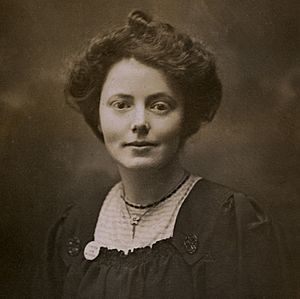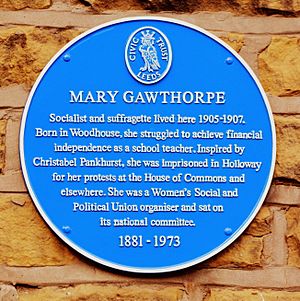Mary Gawthorpe facts for kids
Quick facts for kids
Mary Gawthorpe
|
|
|---|---|
 |
|
| Born | 12 January 1881 Leeds, England
|
| Died | 12 March 1973 (aged 92) New York City, United States
|
| Nationality | British |
| Occupation | Educator, Suffragette |
Mary Eleanor Gawthorpe (born January 12, 1881 – died March 12, 1973) was a brave English woman. She fought for women's right to vote, which is what a suffragette does. She was also a socialist, meaning she believed in fairness for everyone. Mary was also a trade unionist, helping workers get better rights, and an editor of a newspaper. A writer named Rebecca West called her "a merry militant saint."
Mary Gawthorpe's Life and Work
Mary Gawthorpe was born in Woodhouse, Leeds, England. Her father, John, worked with leather. Her mother, Annie, worked in a mill when she was young. Mary had four brothers and sisters. Sadly, two of them passed away when Mary was seven years old.
Becoming a Teacher and Activist
Mary became a teacher in her hometown of Leeds. She taught at Hough Lane School in Bramley. She soon became interested in socialism and was active in the local National Union of Teachers.
In 1906, she joined the Independent Labour Party. She also became the secretary of the new Women's Labour League. Mary then joined the women's suffrage movement. This movement worked to get women the right to vote. In 1905, she joined the Women's Social and Political Union (WSPU).
In 1906, Mary stopped teaching to work full-time for the WSPU in Leeds. Sylvia Pankhurst, another famous suffragette, came to Leicester in 1907. She worked with Alice Hawkins and Mary Gawthorpe to start a WSPU group there.
Involvement with Leeds Arts Club
Mary was an active member of the Leeds Arts Club. Her journalist boyfriend introduced her to the club. She was good friends with Alfred Richard Orage, who was also a teacher in Leeds.
Mary wrote that the club was a quiet place to read and hold meetings. It shared space with the Fabian Society and the Theosophic Society. Many members belonged to more than one group. Mary learned about Annie Besant's writings and ideas about truth and equality there. The club encouraged women to speak in debates. Mary said it brought "a new art reality into consciousness."
Campaigning for Women's Rights
Mary later joined Christabel Pankhurst in Wales. She used her background in the working class and labor movement to connect with people. At a meeting in Wales, Mary spoke perfect Welsh. She asked tough questions to Samuel Evans, a politician running for re-election. This worried him.
The chairman tried to stop her by starting the Welsh National Anthem. But Mary used her strong voice to lead the singing. This made the people like her even more.
In 1907, Mary organized an outdoor meeting during an election campaign. She stood on a wagon in Uppingham with other women. A group of young people started throwing sweets at them. Mary, like a good teacher, smiled and said, "Sweets to the sweet." She kept talking until an egg hit her head, and she fainted. She was carried away but came back the next day, still determined. Sylvia Pankhurst wrote that Mary's bravery made her a hero of the election. Mary also campaigned with Jessie Stephenson and Nellie Martel in another election in 1907.

Mary also spoke at big national events. In 1908, she spoke at a rally in Hyde Park that had over 200,000 people. She was put in prison many times for her political actions. She was also hurt after speaking out against Winston Churchill in 1909.
Arrests and Protests
In October 1906, Mary was arrested after a protest at the House of Commons. She refused to promise to keep the peace and was sent to prison for two months. After being released, she was arrested again in February 1907 for another protest there. She was hurt and could not appear in court, so her case was dismissed.
In November 1907, she was arrested with Dora Marsden and Rona Robinson at Manchester University. They had asked Lord Morley about women who were in prison. The three women were forced out of Lord Morley's meeting and arrested by the police.
In January 1910, Mary, Dora Marsden, and Mabel Capper were attacked while protesting at polling places in Southport. In February, they tried to charge three men for the attack, but the court dismissed the charges.
In February 1912, Mary broke a window at the Home Office. She did this to protest the harsh treatment of a suffragist named William Ball in prison. She wanted to be arrested, but the judge let her go because of her health.
Editing The Freewoman
Mary Gawthorpe was a co-editor of a newspaper called The Freewoman: A Weekly Feminist Review with Dora Marsden. This paper talked about important topics like women's pay, housework, motherhood, the suffrage movement, and books. It was known for openly discussing ideas about right and wrong, and marriage. It also asked for understanding for gay men. Because of her poor health and disagreements with Dora Marsden, Mary left her job as co-editor. Her last article was published on March 7, 1912.
Later Life in America
In 1916, Mary moved to New York City. She continued to be active in the American suffrage movement. Later, she joined the trade union movement, helping workers. She became an official for the Amalgamated Clothing Workers of America union. Mary wrote about her early life and struggles in her book, Up Hill to Holloway (1962).
Posthumous Recognition
Mary Gawthorpe's name and picture are on the base of the statue of Millicent Fawcett in Parliament Square, London. This statue was revealed in 2018 and honors women who supported women's right to vote.
See also
 In Spanish: Mary Eleanor Gawthorpe para niños
In Spanish: Mary Eleanor Gawthorpe para niños


